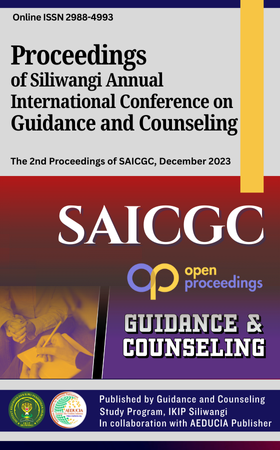Differences in Self-Esteem of Bullies and Victims of Bullying In Class VIII Students at SMPN 56 Bandung
DOI:
https://doi.org/10.64420/saicgc.v2i1.44Keywords:
self-esteem, bullies and victims of bullyingAbstract
Adolescence is a time of developing self esteem which is his identity. Each individual's self esteem is different, this is influenced by the individual's perspective in interpreting each experience, including experience bullying. Bullies and victims of bullying will have different levels of self esteem, because each individual has a different self-assessment. So the purpose of this study was to examine the difference in levels of self esteem of victim of bullying and bullies in class VIII students at SMP Negeri 56 Bandung. The method used in this research is descriptive comparative research with a quantitative approach. The subjects of this study were students of class VIII SMP Negeri 56 Bandung. Data collection techniques carried out by researchers using psychological questionnaires self esteem which has gone through validity and reliability tests. In the validity test, 40 items were declared valid and 8 items were declared invalid. The sampling technique was purposive sampling, so that students who were selected according to the criteria in this study were 8 victim of bullying and 6 bullies. The data analysis technique used in this study is the Mann-Whitney test. The results of this study indicate the value of Asymp. Sig. (2-tailed) of 0.01 <0.05. Then it can be stated that Ho is rejected and Ha is accepted. This it can be said that there are differences in levels of self esteem for victim of bullying and bullies.
References
Andri, P. (2010). Lets End Bullying: Memahami, Mencegah & Mengatasi Bullying. Jakarta: Elex Media Komputindo.
Chakrawati, F. (2015). Bullying siapa takut. Solo: Tiga Ananda.
Clemes, H., & Bean, R. (2012). Membangkitkan Harga Diri Anak. Alih Bahasa: Anton. Adiwiyoto. Jakarta: Mitra Utama.
Engel, JF, Blackw, RD, & Miniard, DW. Galih, A. R. (2020). Pengaruh Layanan Informasi Untuk Meningkatkan Pengetahuan Tentang Bahaya Bullying Pada Peserta Didik Kelas VIII MTS Negeri 1 Pringsewu Tahun Ajaran 2019/2020. UIN Raden Intan Lampung.
Irmayanti, N. (2016). Pola asuh otoriter, self esteem dan perilaku bullying. Jurnal Penelitian Psikologi, 7(1), 20–35.
Komalasari, G., Wahyuni, E., & Karsih. (2011). Teori dan Teknik Konseling. PT INDEKS.
KPAI. (2021). Catatan Akhir Tahun KPAI: Masih Banyak Kasus Bullying Berujung Korban Meninggal. https://kumparan.com/kumparannews/catatan -akhir-tahun-kpai-masih-banyak-kasusbullying-berujung-korban-meninggal1xCdQQVB9QH/1
Linda Hasibuan, Rosya, dan Lita Hadiati Wulandari. 2015. Efektivitas Rational Emotive Behavior Therapy (REBT) untuk Meningkatkan Self Esteem pada Siswa SMP Korban Bullying, Jurnal Psikologi, Vol: 11, No. 2.
Maliana, F. A. (2016). Perbedaan Harga Diri (Self esteem) Siswa Antara Pola Asuh Orang Tua Otoriter Dengan Demokratis Kelas X Di SMA Negeri 1 Kedungwuni Kab. Pekalongan Tahun Ajaran 2015/2016. Empirical Study in Indonesia Pharmaceutical Firms. Systematic Reviews in Pharmacy, 11(2), 545–554.
Maria, I., & Novianti, R. (2016). Pengaruh Pola Asuh dan Bullying terhadap Harga Diri (Self esteem) pada Anak Kelompok B Tk di Kota Pekanbaru Tahun 2016. Jurnal Educhild:Pendidikan Dan Sosial, 6(1), 61–69.
Marwan, D. (2013). Hubungan percaya diri siswa dengan hasil belajar geografi kelas XI IPS di SMA N 1 Bayang Kabupaten pesisir selatan. Jurnal Pendidikan Geografi, 1(01).
Mujiyati, M. (2015). Peningkatan Self esteem Siswa Korban Bullying Melalui Teknik Assertive training. Jurnal Fokus Konseling, 1(1).
Nasir, A. (2018). Konseling behavioral: Solusi alternatif mengatasi bullying anak di sekolah. Journal of Guidance and Counseling, 72.
Pratiwi, M. P., Setiady, I., & Fitriani, N. (2021). Hubungan Kejadian Bullying dengan Self esteem (Harga Diri) dan Resiliensi pada Remaja. Alauddin Scientific Journal of Nursing, 2(2), 84–92.
Priyono, M. (2016). Metode penelitian kuantitatif. Sidoarjo: Zifatma Publishing.
Rahmanillah, C., Pratiwi, E. Y., & Sari, F. H. (2018). Pengaruh Social Support dan Self Esteem terhadap Subjective Well-Being Remaja Korban Bullying di Pondok Pesantren. Intuisi: Jurnal Psikologi Ilmiah, 10(3), 269–276.
Santrock, J. W. (2003). Adolescence: perkembangan remaja.
Sugiyono. (2017). Metode Penelitian Kuantitatif, Kualitatif, dan R&D. Alfabeta.
Wakhid, A., Andriani, N. S., & Saparwati, M. (2019). Perilaku Bullying Siswa Usia 10-12 Tahun. Jurnal Keperawatan Jiwa, 5(1), 25–28.
Wiratna, S. (2014). Metodologi penelitian lengkap, praktis dan mudah dipahami. Pt. Pustaka Baru, 1(11), 99.
Wiyani, N. A. (2012). Memahami Siswa korban Bullying Di sekolah. Ar-Ruzz Media.
Downloads
Published
How to Cite
Issue
Section
License
Copyright (c) 2025 Eti Nurhayati

This work is licensed under a Creative Commons Attribution-ShareAlike 4.0 International License.
Authors who publish with this journal agree to the following terms: (1) Authors retain copyright and grant the journal right of first publication with the work simultaneously licensed under a Creative Commons Attribution-ShareAlike 4.0 International. that allows others to share the work with an acknowledgement of the work's authorship and initial publication in this journal; (2) Authors are able to enter into separate, additional contractual arrangements for the non-exclusive distribution of the journal's published version of the work (e.g., post it to an institutional repository or publish it in a book), with an acknowledgement of its initial publication in this journal; (3) Authors are permitted and encouraged to post their work online (e.g., in institutional repositories or on their website) prior to and during the submission process, as it can lead to productive exchanges, as well as earlier and greater citation of published work.

















